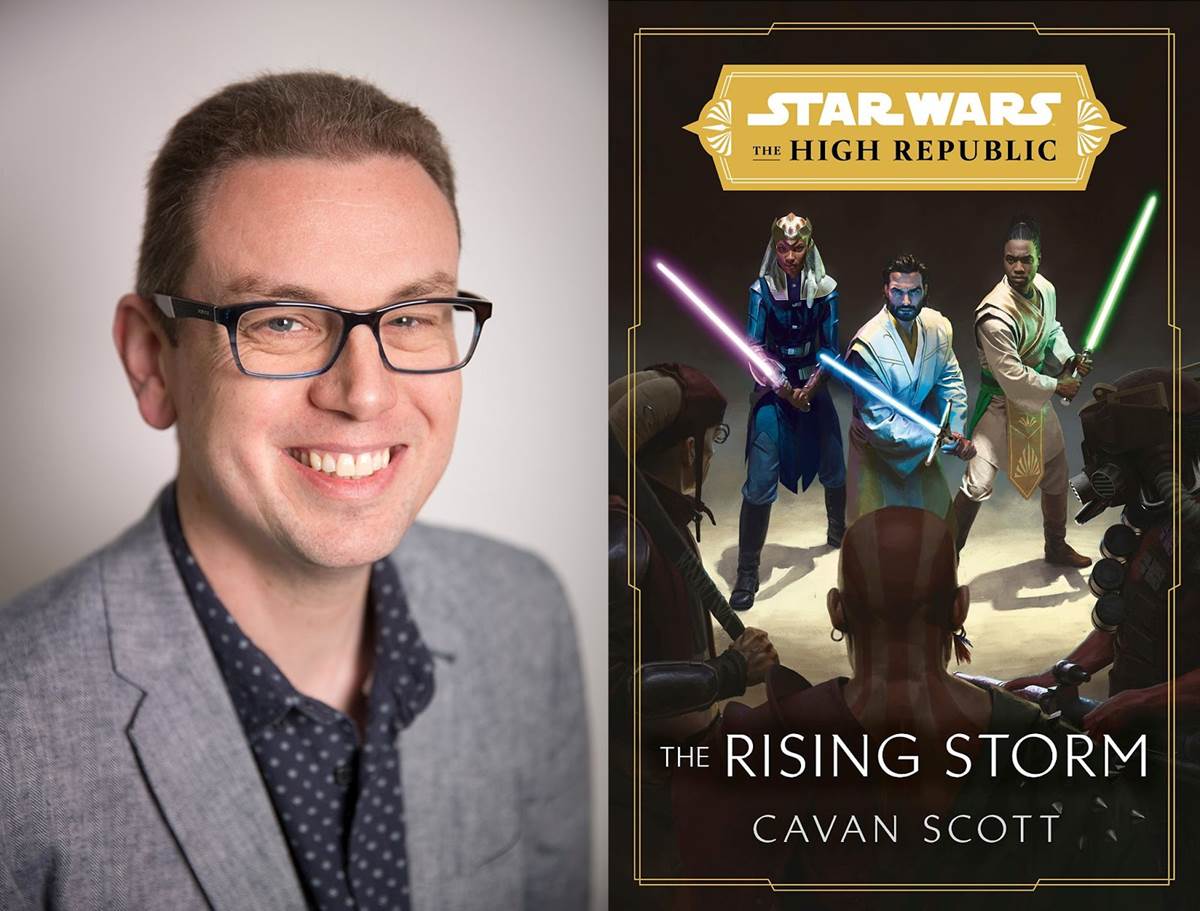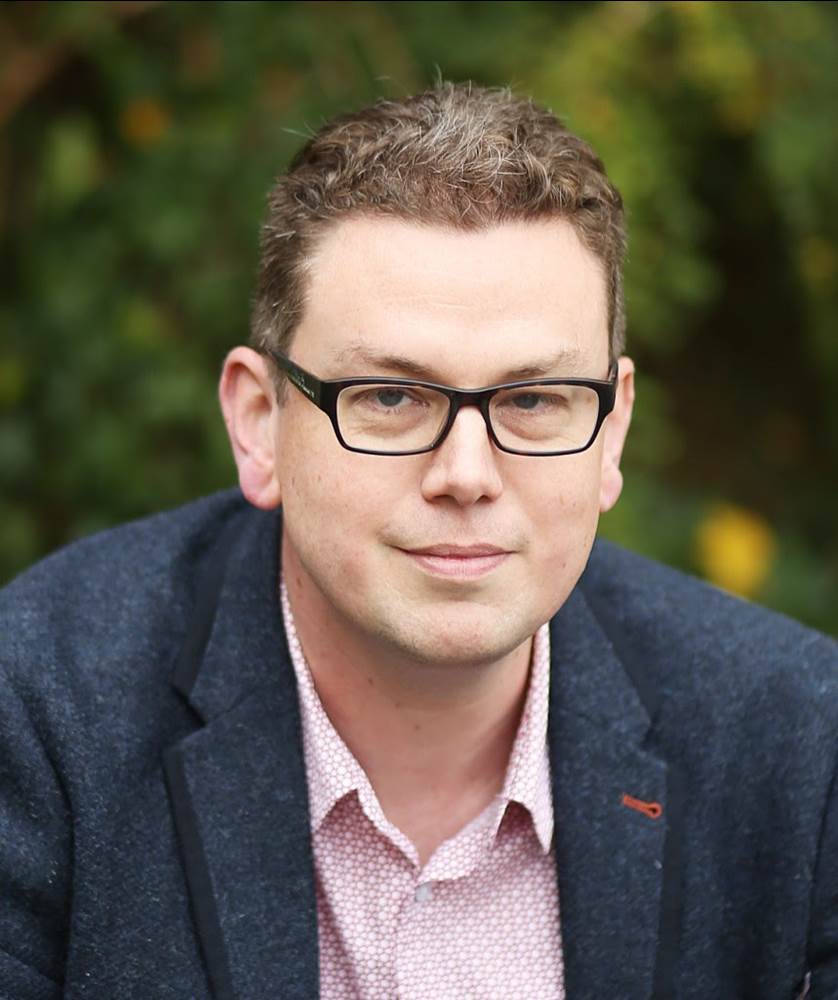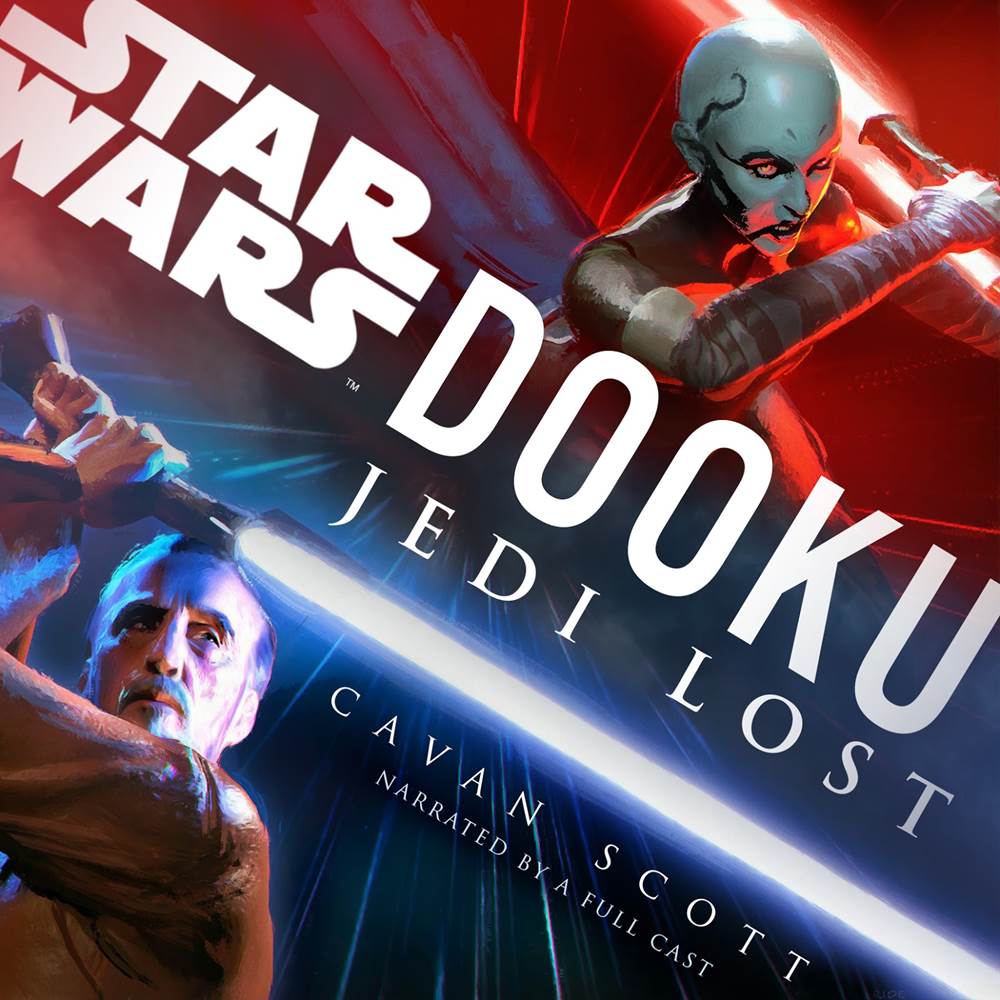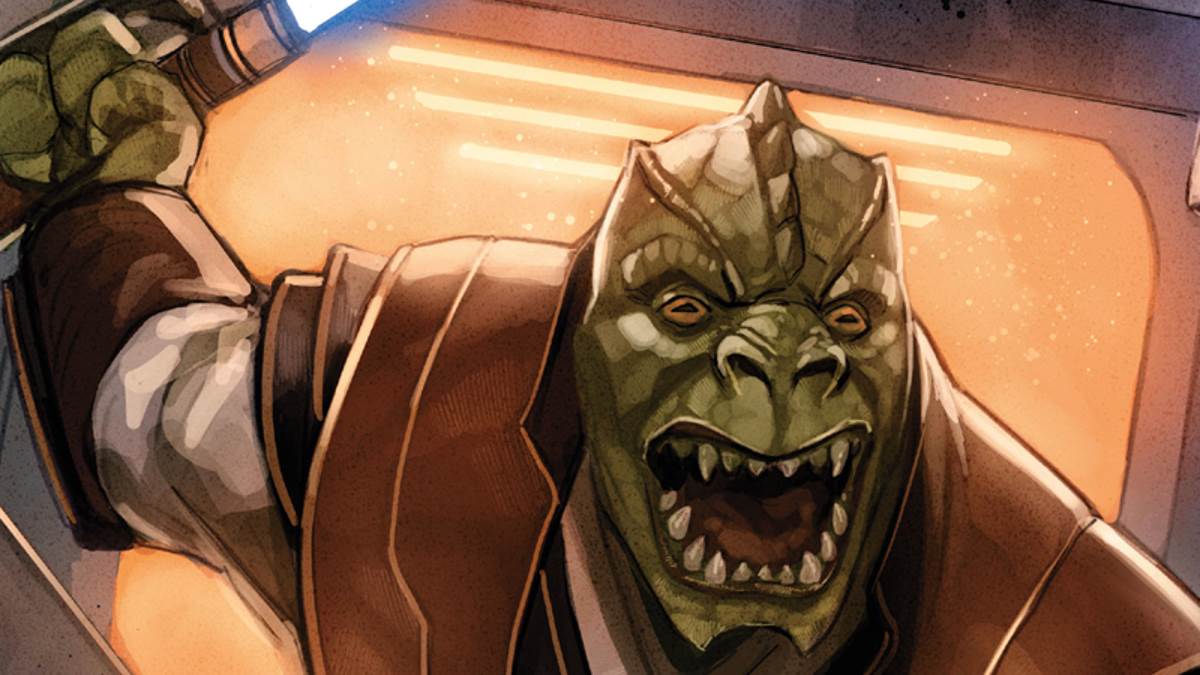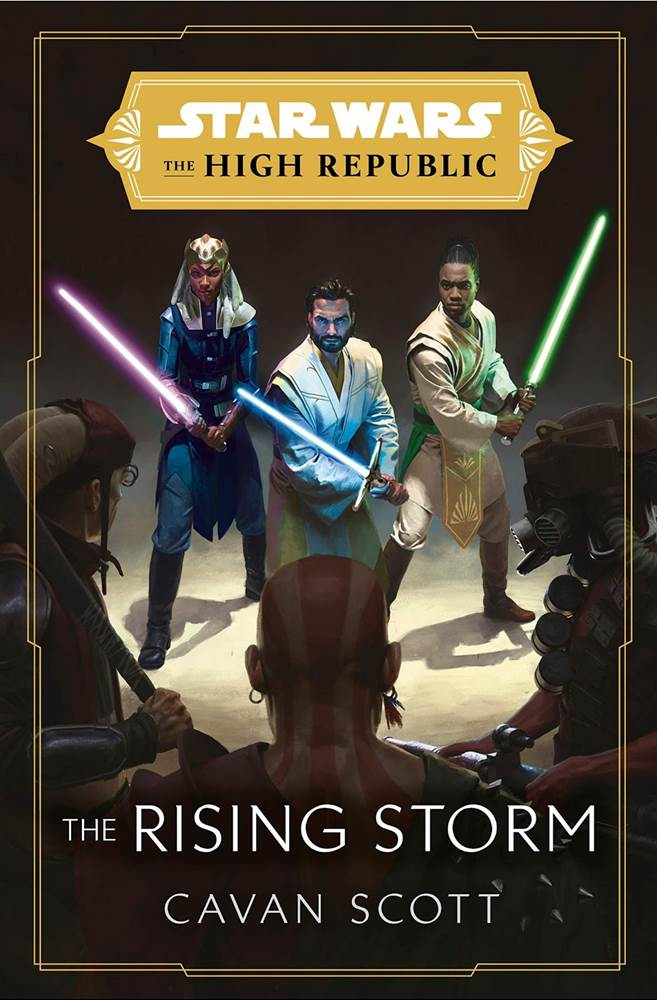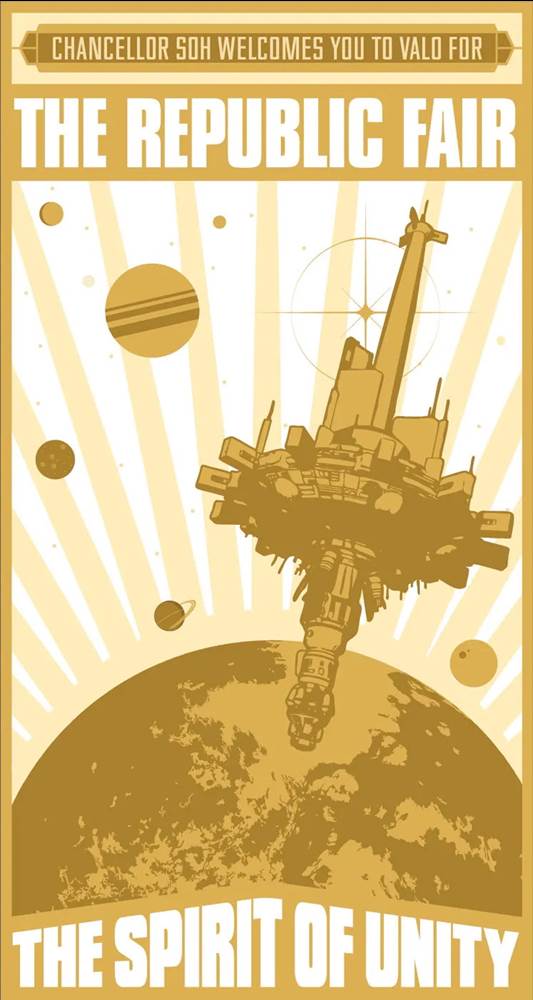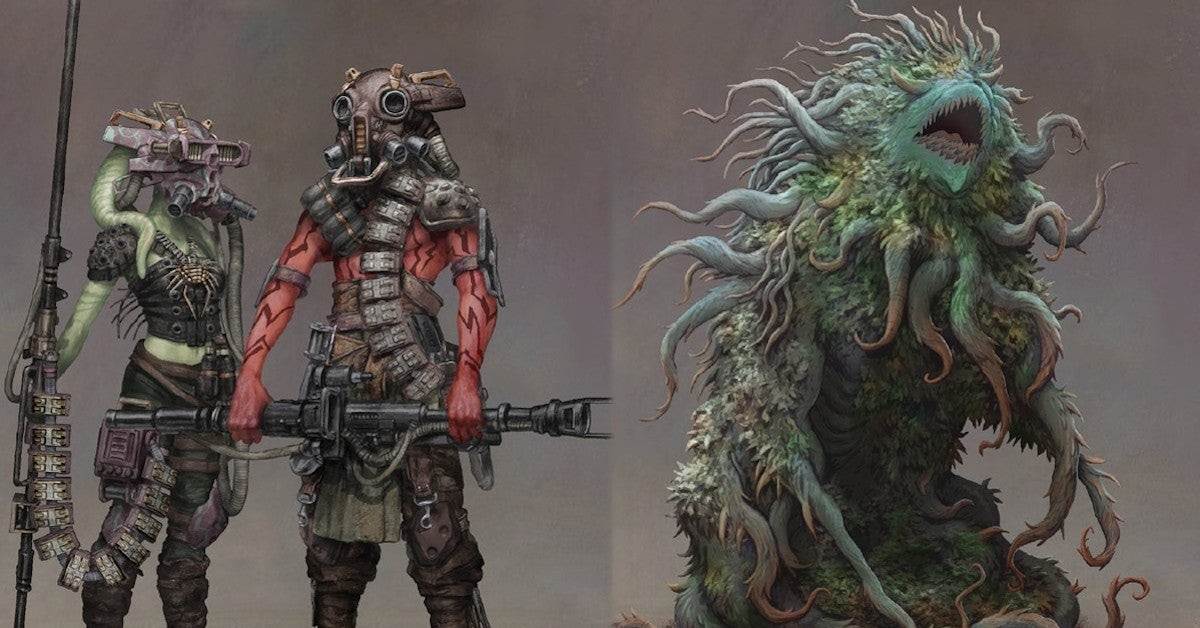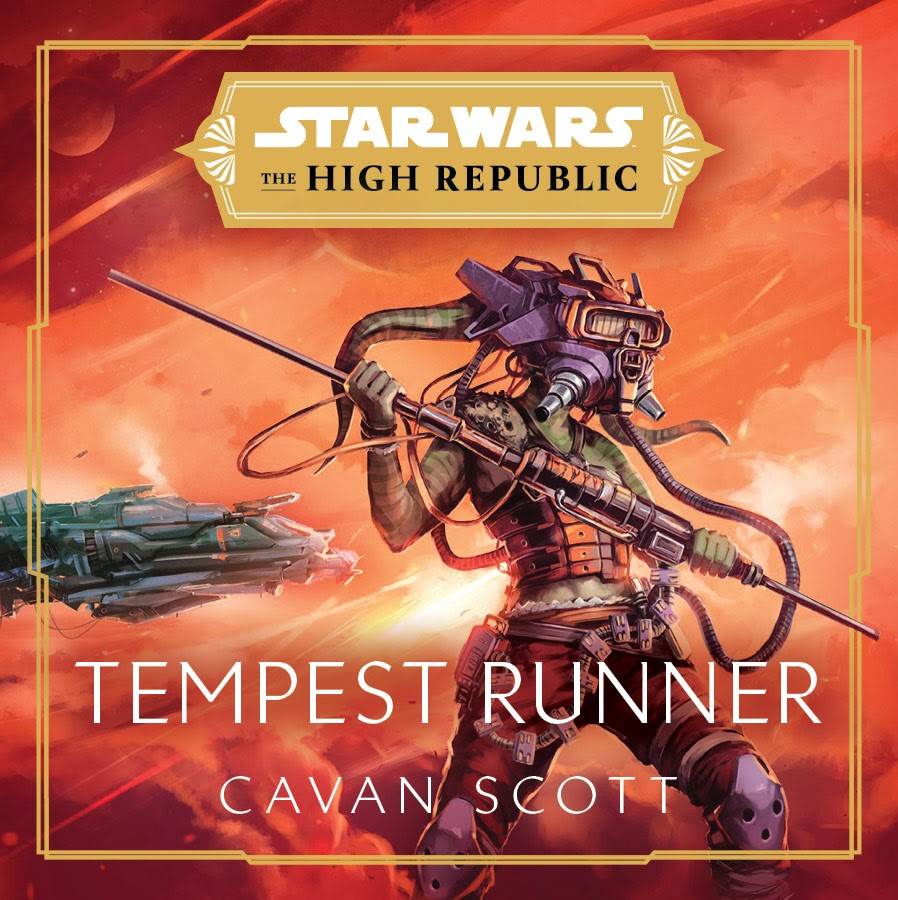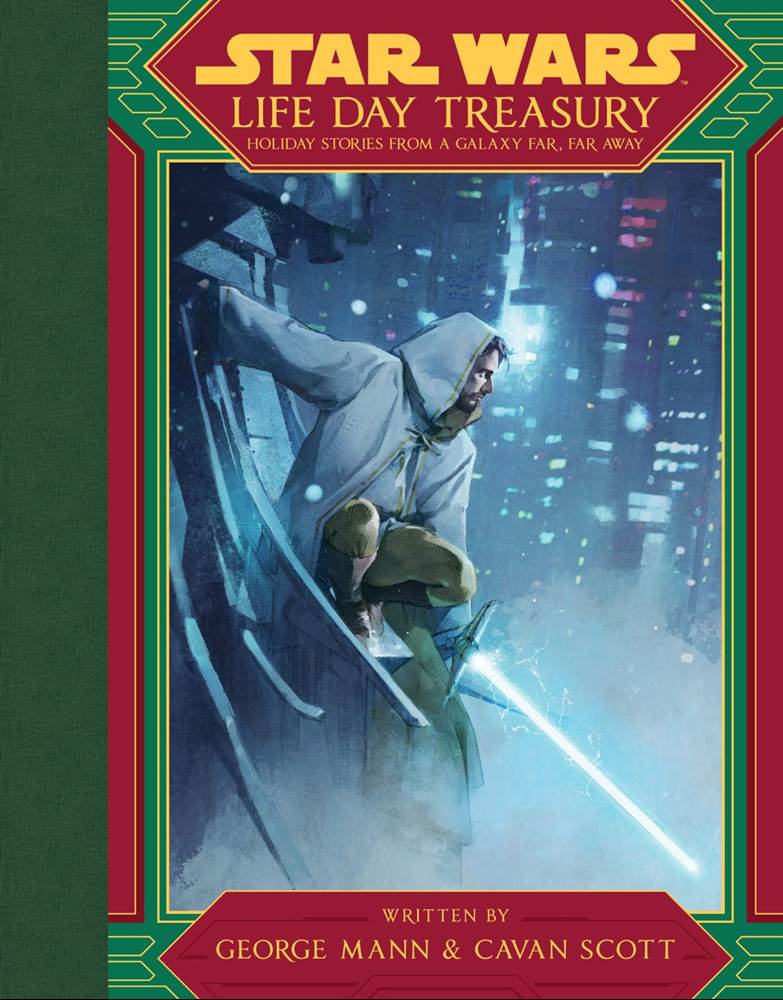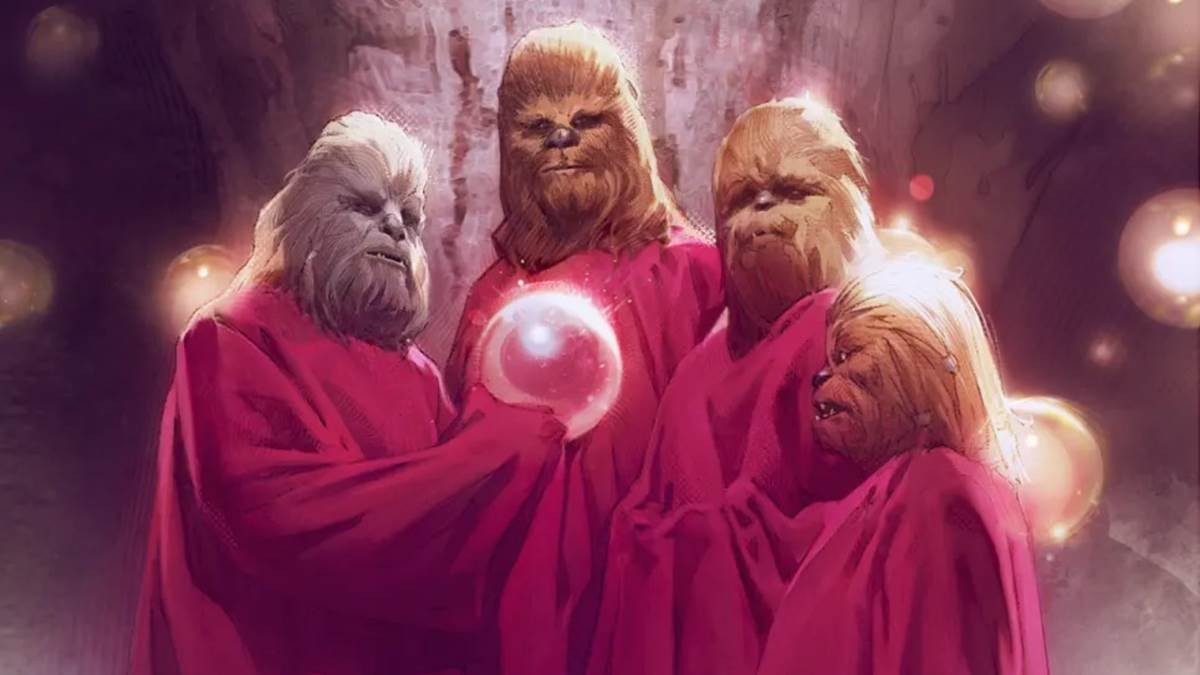Over the past few years, author Cavan Scott has become one of the most prolific creative talents in the Star Wars publishing world. He’s contributed to the Star Wars Adventures and Tales from Vader’s Castle comic books for IDW, wrote the acclaimed Star Wars: Dooku – Jedi Lost audio drama, and even penned a series of Star Wars: Choose Your Destiny books for younger readers.
Currently Scott is one of five main authors collaborating to produce the incredibly ambitious Star Wars: The High Republic multi-platform initiative set two centuries before the Skywalker Saga. He writes the excellent monthly The High Republic comic for Marvel and his new novel is the second adult book in the series from Del Rey, entitled Star Wars: The High Republic – The Rising Storm. I recently had the wonderful opportunity to speak with Cavan Scott over Zoom about his current Star Wars work, what it was like for him growing up with the franchise, and what we can expect down the line from A Galaxy Far, Far Away.
Mike Celestino, Laughing Place: What was your relationship with Star Wars growing up?
Cavan Scott: My first experience with Star Wars wasn’t the movies, but the Marvel comic of the late 70s. Over here in the UK we had Star Wars Weekly, which reprinted the American run and split it into weekly installments and backed it up with whatever Marvel had that was vaguely Star Wars– I think it was Star-Lord for a lot of the run. That was my entrance into it. I knew what Star Wars was, because it was impossible not to. I knew some of the characters, but I had missed Star Wars [the movie]. I was just a little bit too young, and I was quite a nervous kid. Considering I love horror and monsters so much now, it was quite surprising. Chewbacca basically scared me silly when I was a kid.
But I picked the comic up– and it was the first issue that Jaxxon appeared in, which seems to have had a bearing on some of my career since [laughs]– and then got it every week since then, from that first Han Solo story where he gathers together the group of the Star-Hoppers. Then I went to see [The Empire Strikes Back]. For me [via] the comic, I was introduced to Han and the bounty hunters and things like that long before I met Luke, the way it worked. When you’re a kid, weeks seem like an eternity. And then from Empire, I was all in. Although I think it’s still Return of the Jedi that really blew my mind and made me realize that I was always going to love this place, because it was full of so many weird and wonderful creatures.
LP: How did you get started actually writing Star Wars and what has that experience been like for you?
Scott: Around 2015 I was invited to take part in a project that was happening over here called Adventures in Wild Space, which was a new adventure book series they were launching for kids. It was prior to [The] Force Awakens coming out, so Egmont Books had a chance to do a series of books for middle-grade readers. They didn’t want it to be Original Trilogy stuff or Prequel Trilogy stuff because the new movies were coming, but at the same point [they] couldn’t make it Sequel Trilogy[-related] because there wasn’t a Sequel Trilogy yet. Those characters hadn’t been introduced yet, so they came up with this idea of putting together a little corner of the galaxy which could be theirs– a couple of kids as the main heroes, which was something that hadn’t been done since Galaxy of Fear.
At that time, I was writing middle-grade licensed novels for other franchises– everything from Angry Birds to Doctor Who— and so I was asked if I would like to pitch, and [I] bit everyone’s arm off to let me do it, in true Star Wars style. I did an audition piece, which turned into the first chapter of the first Adventures in Wild Space book. Actually, that’s a lie… I had to change it, because I basically wrote the beginning of Rogue One without realizing, and then had to go back and rewrite the beginning of that first book. So that was the beginning, really, and it went from there.
LP: I first became aware of your work with the audio drama Star Wars: Dooku – Jedi Lost. How did that come about?
Scott: Audio drama is where I came from. My first freelance fiction writing job was to write Doctor Who audio dramas. Over here there is a big industry in audio drama, more so than in the states. Twenty years ago I was commissioned to write my first Doctor Who audio [drama], and have written hundreds since in various different series. So I was always always mentioning it and sending Del Rey and [Lucasfilm Publishing Creative Director] Mike Siglain copies of some of the stuff I was doing and going, ‘This is something I’d love to do in Star Wars, because it’s where I came from.’ Star Wars has a history of audio drama with the radio dramatizations, and also adaptations of some of the Expanded Universe material as well.
I had started work on Project Luminous, which became The High Republic, and it was while I was at the first [Skywalker] Ranch trip, I said to Mike Siglain, ‘I’m looking forward to having a few days off.’ And he sort of smiled and said, ‘Yeah, about that…’ And he got into his cab and went off. I sat down, and Elizabeth at Del Rey emailed me within minutes to offer me Dooku. I don’t know if they planned it. So it was a combination of something that they were looking at and me trying to battle down the door to ask if they would consider doing audio drama. And we went from there. I had to tell the entire story of Dooku from age 10 to age 60. ‘You’ve got about six hours to do it, and we want to see him as a Jedi. We want to see him being the Jedi we know he had to be, because of how well-respected he is when we’re first introduced to him as a character, and what a shock it is to the Jedi that he’s become Sith.’ So that’s where it came from, and it was a joy to be the first of a new line in a medium that I’m very passionate about.
LP: I’ve really been enjoying Marvel’s Star Wars: The High Republic comic book that you’ve been writing. I want to ask how Jedi Master Sskeer was created and how you plotted out his tumultuous path so far.
Scott: Yeah, he’s got a journey, hasn’t he? Sskeer came about because Phil Noto– the artist who’s doing our covers and has been working on Star Wars comics and Marvel comics for years; he’s an absolute genius– he did some concept art for the original ideas for Project Luminous. All five of us [authors] had our own idea that we pitched, and he did some art for all five of the pitches. One of those is the piece of art that lots of people see now: a row of Jedi with a blonde female Jedi in the middle that everyone thinks is Avar Kriss– and isn’t– and a number of other Jedi. I became a bit obsessed with trying to find stories for all those Jedi, and one of them was a Trandoshan. I just loved the idea of a Trandoshan Jedi, because I struggle personally with monocultures in science fiction, whether that’s in Star Wars or elsewhere.
I loved the idea of a Trandoshan going against their nature, or the nature that’s perceived by the galaxy as a whole. So I started to try and work out who he was. It was interesting because his relationship with Keeve [Trennis] came really late in the day. He was always going to play a major part in the comic, and his arc– which we haven’t really explained yet, so I can’t go into too much detail about it– what he’s going through and why he’s struggling so much in the Force, that was part of that original character sketch that I wrote looking at that piece of art from Phil. And then at the last minute, when I was just about to submit issue #1, it still really wasn’t working. I suddenly realized he needed to be Keeve’s master. That wasn’t their relationship at first. He was like a trainer; he was someone who was overseeing a lot of the Padawans on Starlight Beacon. It just wasn’t having the emotional punch that I needed it to have.
As soon as I realized that they’re Master and Padawan, and we’re going to see her reacting to what’s happening in Sskeer’s life as the nearest thing to a daughter that a Jedi can have, that’s when it started to really ram home for me of what that story was going to be. Everything clicked into place. Sskeer’s journey was always going to be troubled. Let’s put it that way. Now it’s a lot more personal, as well, which is exactly what we needed.
LP: The Rising Storm is being promoted as the second adult novel in Star Wars: The High Republic, but what does the word ‘adult’ mean in that context? Why are the books being separated in that way?
Scott: I think it’s because we can deal with more adult themes, and by ‘adult themes’ we mean that we can get into more depth into the darker side– every pun intended– of the Star Wars galaxy. While Star Wars junior fiction never shies away from deeper meaning and deeper characterization, there’s some stuff you just can’t do in middle-grade and [young adult] books. With the adult books from Del Rey, it should never be something that a kid can’t read. If a kid is a good reader and they want to read one of the Del Rey novels, it should never be something that isn’t appropriate for them. Because it’s Star Wars, and Star Wars is a family experience. However, there’s a chance to give a bit more depth, to look at what life would be like in conflicts throughout the history of this galaxy. Let’s face it, some of them are quite intense, so it’s giving that little bit more. Younger readers can absolutely read Del Rey novels, but it does cater [to] a slightly older reader.
LP: This novel takes place after the events of Charles Soule’s Light of the Jedi and also overlaps with some of the other High Republic books. What is the collaborative process between authors of planning out the larger story beats of this series?
Scott: As a group, and working with [the Lucasfilm] Story Group and the editorial teams and all the various publishers, we come up with the overall plan. It’s been announced that there are three phases to The High Republic, and we know how it ends. We know what Phase 1, Phase 2, and Phase 3 [are], and we know the major beats of each of those phases. Then we know that there’s going to be certain novels and comics within that, and now audio books and everything else that’s coming from The High Republic, so we start pushing some of those beats into those particular parts. Originally we were working just as a group, and then when [the individual books] were assigned, we were then asked to take those beats that we’d assigned to that particular book or series and develop them more. Bearing in mind everything else that’s going on, there is a lot of back-and-forth.
We talk most days, the five of us: ‘I’m about to do this in my plan for this book. What does that mean?’ Or the cry goes out: ‘Where is Keeve at the minute?’ or ‘Is such-and-such on Starlight? Is such-and-such on Coruscant?’ There’s a bit of back-and-forth there, and actually the best ideas come from those moments, because there have been times when two of us have been wanting to do something with the same character, and you obviously can’t, so you have to work out how a character could either be in two places or ‘Is there someone else who can replace that character?’ The general plot was developed together from the initial idea, and then we’ve all had our little corners that we’ve had to develop. It’s been a bit different for me and Daniel [José Older], because we’ve obviously had the two comics running through everything. We’re supposed to be providing a bit of a spine, while also being its own little thing.
I’ve written quite a lot of this middle section of the first phase, which meant it’s been good that I have been able to pull everything together a bit as well, as other people have been concentrating on elements for later on in the phase. It’s a lot of conversation and a lot of planning, but still giving us the chance to have discovery as well, and that’s what’s been really important. Just like I mentioned earlier with Sskeer, there has to be the moment when you’re writing that you go, ‘Hang on a minute– what if this happened?’ That can have a domino effect. Sometimes those domino effects are exhilarating because you’ve suddenly realized it’s opened up an entirely new window of opportunity for drama.
LP: The Republic Fair is the centerpiece of The Rising Storm, and I love that it is obviously influenced by the real-world World's Fairs. What inspired you and the other authors to come up with this idea?
Scott: I can’t remember who came up with the idea for the Republic Fair. It was quite early on in the process, and it was that sense of a brave new world that World’s Fairs in the past have brought: the idea of progress and showing the world– in the case of World’s Fairs– what a country or a society or an age will bring… what they can do. We wanted to open that up to the galaxy, and it tied in very well to the entire idea of [Chancellor] Lina Soh’s Great Works that she was running through. All of us are fascinated by the World’s Fairs of old. I’ve got books galore of pictures [of the World’s Columbian Exposition in] Chicago, and also London Exhibitions over here, and Paris from the Victorian era. That’s where it originally came from. It’s going to have an effect on everything, just in the same way as the Great Disaster in the first wave affected everything around it. Some of the stuff actually takes place during it, and other elements take place as the dust has settled.
LP: I noticed that the Republic Fair contains homages to Walt Disney’s contributions at the 1964 New York World’s Fair, but I also got a taste of EPCOT Center in the fair’s layout. Are you a fan of Disney theme parks, and if so, why do you feel that Star Wars and Disney Parks go together so well?
Scott: I’m absolutely a fan of Disney Parks. I’m just a fan of Disney, to be honest. Let’s face it, [Star Wars and Disney Parks] have gone well together long before Galaxy’s Edge. Star Tours, with the original Captain Rex. [laughs] They’re about experience. Star Wars and the Disney parks are about immersing yourself in another land, whether that’s the Happiest Place On Earth or A Galaxy Far, Far Away. As soon as you walk in, as soon as you enter a Disney park, you are surrounded by Disney. The music, the sights, the sounds. Everything there is designed, and that’s why I am fascinated about the Disney parks. It’s an experience that is absolutely engineered to bring out certain emotions, to make you feel a certain way, to excite you, to comfort you as well, I think. And to be an oasis.
In the same way, Star Wars– because of the way George Lucas created it– because it is a lived-in world, that’s why I think the two go so well together. After we did the press launch of The High Republic in February last year, which seems like an eternity ago now, the next day we all went off and spent a day at Disneyland– the five of us [authors] and Mike Siglain, and various family members. A lot of us were going to Batuu [in Star Wars: Galaxy’s Edge] for the first time, and there was a moment where Justina [Ireland] and I were walking along by the [Millennium] Falcon, and we hear the sound of a ship going off, and we both turned and looked in the same direction. We both looked up, imagining that a cruiser was taking off behind us. That’s what I love about it. That’s definitely why I think they work together.
I’m a former magazine editor and in my more recent life as a comic writer I spend a lot of time at conventions in San Diego and things like that. And while the Republic Fair is very much divorced from San Diego Comic-Con, it’s a world I’ve always enjoyed– that world of setting up experiences for people. It just seemed a very natural fit.
LP: How do you feel the Nihil and the Drengir complement each other as villains in The High Republic? Which of these factions is more fun to write?
Scott: That’s a tough one. I think the Nihil are more fun in a way, because while I’m a monster guy– I love writing monsters, especially creeping, crawling insidious cosmic-terror-type monsters, which we get a lot of in the Drengir– with the Nihil, they’re just snarky. The Drengir aren’t very good at conversation. It’s basically ‘Meat. Feed.’ Unless you get someone like Sskeer talking for them, being their spokes-Trandoshan, they’re quite monosyllabic. And while I have no problem writing monsters like that, I’ve loved getting my teeth into the Nihil… especially in the higher echelons of Pan and Lourna– our new Tempest Runner– and Marchion Ro.
Writing villains is always fun because villains can do anything they want, and they can do the things you sometimes would want. I’m not saying I want to do everything the Nihil do, especially in this book [laughs], but all bets are off with them. When you’re dealing with characters like Pan and Lourna, they don’t care what they sound like. They will just say it as it is, so it’s quite liberating to be able to write that, and to be the kind of person through your characters that you would never dream of being– that it would mortify you [to be]. So I think that’s why the Nihil are just edging ahead of the Drengir for me. But it’s going to be interesting when people start to realize how they’re all linked in, and what they make of that.
LP: Beyond the comics and The Rising Storm, your next entry in The High Republic is going to be the Tempest Runner audio drama. Without spoiling anything, how excited should we be about that coming out, and the future of The High Republic beyond that?
Scott: Well, I think obviously you should be very excited about Tempest Runner! [laughs] Hopefully people enjoy Tempest Runner, because it’s giving us a look at the High Republic from a very different point of view. A lot of The High Republic material so far has been based around Jedi, and that was a very definite decision. With Tempest Runner we see Jedi, but we see them through the eyes of other people, whether that’s Republic people or whether that’s the Nihil themselves. And we obviously do a deep-dive into Lourna, so we explore who Lourna is, why she got to this point, and where she’s going, building on the events that we see in Rising Storm. I find it very exciting personally to map out this part of Lourna’s life, because it is setting the stage for a lot of the stuff that’s going to come beyond phase 1.
It’s also a chance to hear some of the Jedi that you’ve been reading. Obviously [audiobook narrator Marc Thompson] is wonderful, but I always think there’s something special about drama when you actually hear actors breathing life into those characters. So you might hear familiar characters from some of my other High Republic work being performed, which is very exciting. Beyond that, I’m a bit biased, but I can’t wait for people to experience what we’ve got coming up. This is really only the beginning. The first wave was the pre-title sequence. We’re now getting into the first act of The High Republic, so we’ve got a lot of story to come, and a long way to go. I’m really excited to see where it goes, to see the reaction of readers– because the reaction of readers does change the direction sometimes when you’re writing, when you realize that certain characters are chiming in a way that you didn’t think they’d be.
We have all these points plotted out, and we have to hit them. Sometimes we’re going to take little swerves to hit them in a different way because of the reaction to certain characters. That’s exciting, because it is an organic, growing part of the galaxy. We know exactly where it ends, but I’m looking forward to seeing some of the ways we get there.
LP: What can you tell me about the other Star Wars book you’re working on, Life Day Treasury, which you’re writing with your friend George Mann?
Scott: Life Day Treasury is along the lines of the books that George has been writing– the [Myths & Fables] type books, which are stories of mythology and folklore that are told in-universe. It’s something I’ve been pushing independently, to do some kind of treasury of short stories set within the various winter festivals or Christmas analogs we have in A Galaxy Far, Far Away. George is one of my best friends. I’ve worked with him on various things [but] we’ve never worked together on Star Wars. I pitched and suggested the treasury, and Mike Siglain said, ‘How do you feel about bringing George in and making it part of that series?’ I said, ‘As long as it’s alright with George, because he’s writing those books, it’s definitely alright with me.’ We’re both massive fans of A) Christmas, B) ghost stories, and C) ghost stories about Christmas. I’m not saying that’s [entirely] what the book is full of, but it’s definitely that kind of Christmas story.
It’s folklore, it’s traditions, it’s families. There are some spooky stories in there, as well. It’s a lot of fun. And at the end of the day, the two things that I think I’m most excited about is that we get to do Ewoks in the snow. Anyone who knows me knows I love my Ewoks. And we get to do Chewbacca’s family. That has been a complete and utter joy.
Star Wars: The High Republic – The Rising Storm is available now wherever books are sold, Marvel’s Star Wars: The High Republic comic book is released monthly, Star Wars: The High Republic – Tempest Runner will be released on August 31, and Star Wars: Life Day Treasury will be released on September 7.

